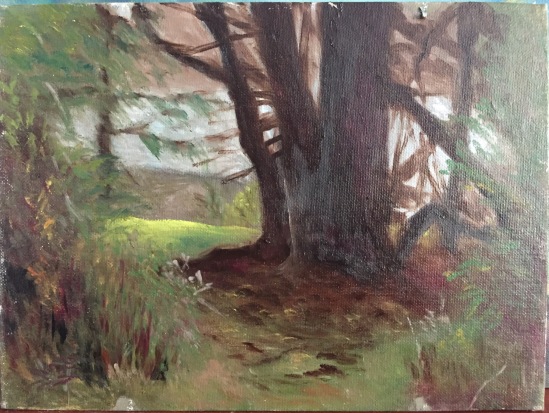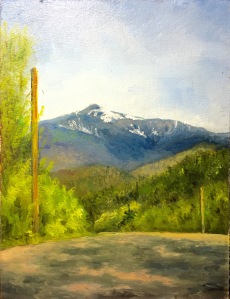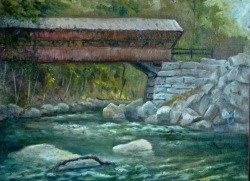On October 6, I drove to Acadia National Park in Maine to take part in “Fall Color Week” (third annual) promoted by the publisher of Plein Air Magazine, Eric Rhoades. I’d been feeling a little down, not wanting to get outside and paint, so when the invitation came, I decided it would be a Good Thing to Do. Expensive, but worth it in terms of the facilities. At least I could drive my own car to get there. Most of the 60 participants flew into Portland or Bangor airports from the West Coast, the South, the Midwest. To those participants, the fall color foliage was particularly alluring. For all of us, the idea of Acadia conjured up visions of Cadillac Mountain, Bar Harbor, Thunder Hole, and other visions of Mt. Desert Island memorialized by master artists.
Alas, I discovered when I got there that the section of Acadia National Park where we were was entirely separate from the section to be found on Mt. Desert Island. We were on Schoodic Peninsula, housed in the Schoodic Research and Educational Institute. Bar Harbor was an hour’s drive away, taking the short cut–more of which later. Besides, Mt. Desert Island was overrun with tourists. Big cruise ships were making calls there. Busloads of visitors. Schoodic was a much more desirable place to be, with easy access to fishing villages and other vistas, but before reaching that conclusion, I would have to try to paint on Mt. Desert.
We arrived at the beginning of Columbus Day Weekends, the traditional peak of foliage season, planning to explore Schoodic for a few days waiting for the tourists to leave Mt. Desert. The Peninsula offers a lot of rock, both along the road and extending out to sea. Fir trees dominated all tree lines so there was less “foliage” there than back home. My first stop was Blueberry Hill. (Blueberry bushes do provide a large proportion of the red foliage up there.) At Blueberry Hill, I chose to look outward, at a fir-covered island while the sun struggled to break through a very clouded over sky.

I spent a long time on this, my first painting of the week. So often my first painting of a series turns out to be the best, and I gave it my all, dabbing away at the clouds and rippling waves until I was sure I had captured their variety within what was a relatively sedate range of colors. As it now turns out, Blueberry Hill was indeed one of my more successful efforts.
After lunch (a bag lunch that I made up from stuff laid out for us at the dining hall), I went looking for some color along the Schoodic Loop Road. I found a roadside brimming over with reds and yellows and greens, near the bike trail called Bunker Harbor. Feeling inspired to make a masterpiece, I got out one of the bigger panels, 12×16.

To top off the day, I set up on Schoodic Point, where roseate rocks spread way out into the sea. Artists were sprinkled all over the landscape. I had to set up at the edge of the road because my balance is not good enough to get me and my gear across such uneven surfaces. I did not give this second effort as much attention. Sketchy. But I think you get the idea.

I was proud that I had produced three paintings on the first day. Better than most (only in terms of numbers–there were some very accomplished painters there).
The next day, Sunday, was extremely foggy. Eric had suggested that we drive over to a fishing village called Corea. About 45 minutes to drive there: 20 minutes to get off the Peninsula, turn right (North), then East again down another long arm into the ocean. I got there early and could not find other artists, or any parking spots. We had been warned about respecting “Private Property” and “No Trespassing” signs. I drove around and around until finally I made a desperate move: I turned into a dirt road that led to the harbor, despite the sign that said “Ivy’s Way Private Way”. There were two wooden walkways into the water (docks?), surrounded by boats and fishing gear (lobster cages, in particular)–and a small cottage. I knocked on the door with some trepidation. The door was answered by a couple from Missouri (!) who have rented the cottage every summer for the past ten years. The owner lives in a building across the main road, and quite the building that was. Modern, large, industrial, Bauhaus in flavor. The owners rent the water access to the fishermen and “wouldn’t mind at all” if I set up to paint there. The fog had lifted slightly and I was able to spot a white house way up on a hill that was solid rock, with a lobster boat moored below. I had my composition. The fog continued to lift until it was all gone by the time I was finished painting. I left the background trees in the fog.

I believe the next “assignment” was to be a lighthouse that was near Corea. I went there and waited for some other artists to show up, but none did, and the wind was too fierce for me get out of my car. I took a nap. Then I returned to Schoodic, Frazer Point, and painted this little quickie.

That night, after dinner, someone got one of the artists to volunteer to model for portrait. I watched for a while, then realized my gear was just outside in the car and I should have brought it in to paint the portrait. After all, I’d rather paint a figure than rocks any day. I would be ready the next day.
Monday, Day Three, the day we hoped to paint on Mt. Desert Island. I got set, started out early. The shortcut required finding Mud Creek Road, which I had no trouble with. But Mud Creek Road ended in a “T” intersection and, not knowing which way was correct, I chose left. (No reception for cell phone meant my GPS was no help at all.) I ended up on Marlboro Beach Road in or near a town named Lemoine, staring at a very special view of Mt. Desert Island. I pulled over to get a good look, and was also able to get GPS there. I was not on the correct route to Mt. Desert, so I backtracked and got to Thunder Hole, where we were supposed to gather, about 11 o’clock. Almost the whole morning was spent driving around.
At Thunder Hole, I doped out a spot where I could set up to paint without getting out on the rocks, but to what end? I could not see the Hole from there. In fact, the Hole was pretty darned dry in not-high-tide. So I went to the next recommended spot, Otter Point. Parked and got my gear out of the car with a determination that, after all this driving around, I was going to produce a painting here no matter what. I stopped on the side of the road looking down. I painted until the rain started. Something to do with hurricane Nate?

I spent the rest of the afternoon exploring the area by car, and drove back to Schoodic in time for dinner. After dinner, our portrait model was Rick Wilson, a painter that Eric had recruited to keep us entertained by playing guitar and singing. As a model, he was not trying to keep still for the portrait painters, but I didn’t mind.

Tuesday, Day Four, another Mt. Desert attempt. We were supposed to all be on top of Mt. Cadillac by three in order to be photographed en masse. Meanwhile, I wanted to paint that scene I discovered on Marlboro Beach Road. I invited others to join me, but there was a spot on Mud Creek Road that was pretty attractive, and nobody got past that. (Nobody seemed anxious to go all the way to Mt. Desert.) Anyway, I easily re-found Marlboro Beach Road and got permission from homeowner to set up and paint his view. It went quickly, despite the fact that I used 12×16 panel.

After Marlboro Beach, I headed for Jordan Pond on Mt. Desert. Again, it was the suggested site for painting prior to Mt. Cadillac. The Pond was downhill from the parking lot. It took a lot of patience to snag a parking spot. I had to lurk. (There was no way I was leaving without getting a crack at the restroom!)
It was going to be hard to get my gear back up that hill but I was determined to paint there. To reduce my burden, I left my chair in the car, hoping to find a suitable rock to sit on. (My back does not allow me to stand long enough to complete a painting.) Down by Pond’s edge, I found the perfect sitting rock, but I had to face up the hill, not at the pond. Well, it was only water and rocks and trees anyway. Uphill I had trees and shadows. Another artist from the group, with his wife, showed up, but not painting. Still it was nice to see a familiar face. When I went to leave, I got halfway up the hill before a kind couple took pity on me and dragged my cart up to the top.

At that point, I was looking forward to the top of Mt. Cadillac, but I never got there. The Park Rangers had barricaded it because the parking lot at the top was full, and the line waiting to get into the parking lot had filled the road. No room for anyone else. Wow. I headed back to Schoodic, glad I had at least got one painting done on the Island.
After dinner, I painted another portrait–this one of Vicki. Vicki kept very still.

Wednesday, Day Five: Beautiful day. Two of us shared a pullout in the Schoodic Loop Road–my companion looked out upon the water and a tiny fir-covered island; I was taken by the combination of rocks and shadows over the rocks and road. This is probably my favorite painting from the week, 12×16, unretouched. My experience was marred by voracious flies that bit right through my clothes. (I added two more layers the next day.)

After lunch, I went exploring the little fishing towns between us and Corea: Prospect Harbor had a big regional lobster pound, very industrial-looking building. I drove in and around and behind it where I had a view of a funny little lighthouse. Remembering how awful the conditions were for that other lighthouse, I figured why not, it’s a lighthouse. Why not is not a good reason. It was my worst painting, even after I retouched it. I’ll show you After.

After
Thursday morning, six a.m.: Sunrise scheduled to be 6:45 so I figured I had plenty of time to get out for a sunrise painting. There was a good spot right at the entrance to our Institute buildings. Eric was already there, said the best light had already gone by. I didn’t believe him. About six more artists were also clustered around easels. Eric was using a little easel light. I had not thought to bring one with me. Didn’t matter, by the time I was set up. there was enough light to see sort of what I was doing. Couldn’t really see it until I got indoors.

Thursday was our sixth and last painting day. I decided I needed more boats. On the Loop Road, there was a restaurant called Bunkers Wharf, and it looked down on Bunkers Harbor. There were already a few artists painting there and I had heard talk of some painting inside on one of those really bad days. I joined the group outside–there were four of us. Of course I had my usual bag lunch, but the others were ordering food and I could never resist steamed mussels. Lunch was a lovely experience. I went inside to order the mussels, but the young man brought them out to me when they were ready, and later came back for the empties. He told us of his plan to buy some real estate and put up condos to lease out to Acadia visitors.

After Bunkers Wharf, I wandered around Winter Harbor but never felt the urge to set up and paint. After dinner that night, we set all of our paintings out for everyone to view. It was too much to absorb. Incredible works of art all around me. I felt exhausted. And I feel exhausted all over again now. Hope you enjoy!


















